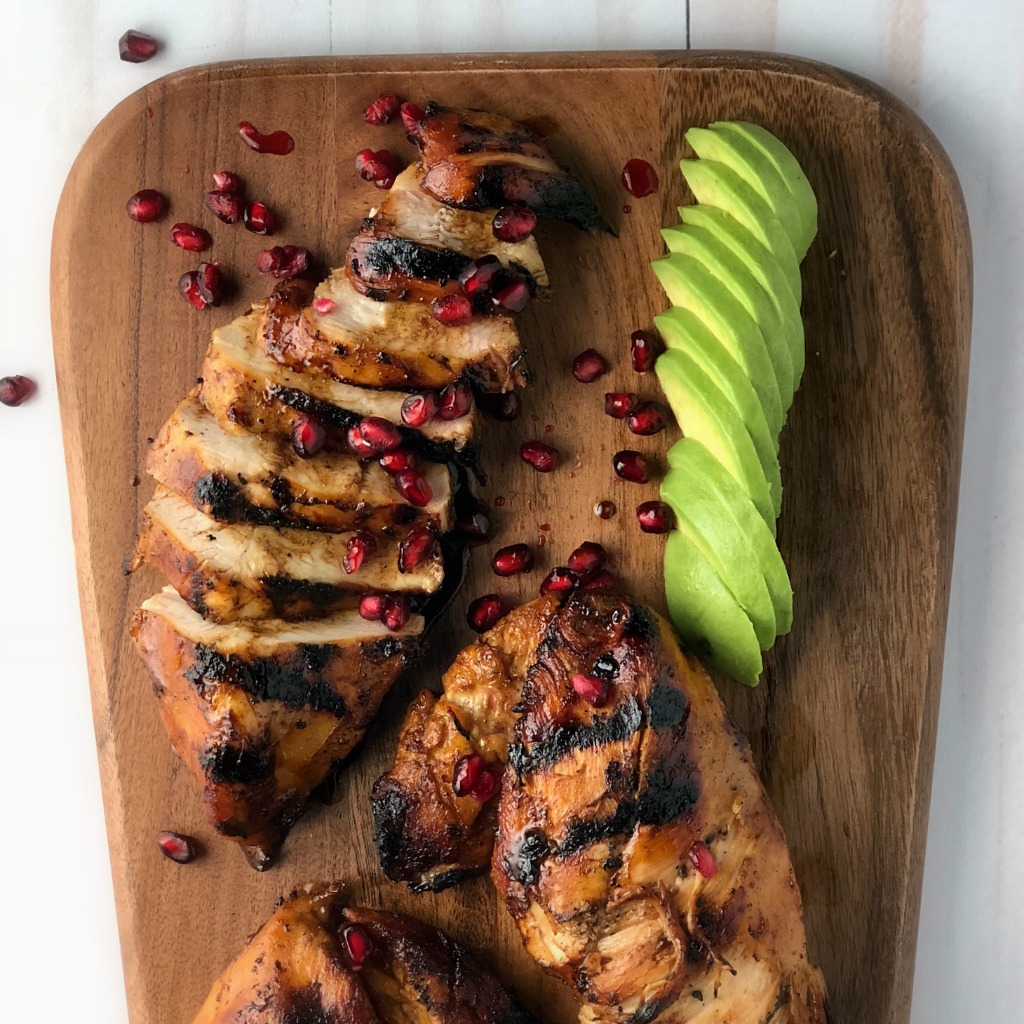
Apple-Pomegranate Grilled Chicken
Want to bring a little brightness and pizazz to “chicken night”? This recipe answers that call. It turns ordinary chicken breasts into the juiciest cuts. And, it’s so, so easy to make—the marinade doubles as a finishing glaze and consists of mostly measure-and-pour-style ingredients (a.k.a. not a lot of chopping!). It’s wonderful with my Chunky Guacamole as a topper or taco twosome.

- 1/4 c. 100% pure apple juice
- 1/4 c. 100% pure pomegranate juice
- 1/4 c. olive oil or canola oil
- 2 tbsp. honey
- 2 tbsp. balsamic vinegar
- 2 large or 3 small garlic cloves, grated or minced (or 1/2-3/4 tsp. granulated garlic, see TIP A below)
- 3/4 tsp. kosher salt
- 1/2 tsp. fresh ground black pepper
- 4 boneless, skinless chicken breasts, (or 1.5-2 lbs. lean meat of your choice)
- seeds from 1 pomegranate (optional)
-
Combine the first 8 ingredients (everything except the chicken) in a 2 to 4-cup measuring cup or medium bowl and whisk until well-blended. Pour half of the mixture into a large ziplock bag (this is the marinade) and reserve the remaining half covered with plastic wrap in the fridge (this is the start of the glaze).
-
Add the chicken breasts to the ziplock bag and seal tightly. Gently massage the marinade into the meat. Then refrigerate the chicken in the bag for at least 4 hours or up to 6 hours if possible.
-
Remove the bag of chicken from the fridge about 30-40 minutes before you are ready to grill. Heat your outdoor grill to 425-450°.
-
While your grill is heating-up, pull the reserved marinade from the fridge (the portion that you kept separate from the chicken) and transfer it to a small saucepan over medium heat. Bring it to a vigorous bubble, then reduce heat to medium-low and let it simmer (stirring frequently) for about 20 minutes until it thickens slightly and becomes glaze-like. Once done, turn off the heat and leave the glaze to stay warm in the pan until you are ready to serve. (See TIP B for what to do if it becomes too thick.)
-
Once your grill comes up to temp, thoroughly coat the grates with vegetable oil and then lay the chicken breasts flat across the warmest area of the grill. Immediately discard the ziplock bag with the residual marinade. Grill the chicken breasts on each side until cooked through (approximately 6-8 minutes per side). Resist the urge to flip or move the chicken breasts around too much so that they develop nice grill marks. Once done, let them rest at room temperature (off heat) for 5-10 minutes to re-absorb their juices. Then serve sliced or whole with a drizzle of the glaze and sprinkle of pomegranate seeds (if desired).
TIP A: If you follow my recipes, you've probably noticed that I'm a bit sporadic in when I recommend the use of granulated garlic (a.k.a. coarse garlic powder) vs. whole garlic grated or minced. They can be interchangeable—however not in the same quantity. In most sauces and marinades, using a high quality granulated garlic in the place of minced or grated fresh garlic is perfectly fine—in fact, sometimes even preferred. Granulated garlic is often more intense in flavor, but because it is ground and dry, it easily blends into liquid mixtures. Fresh garlic has a more complex and savory flavor that typically mellows when you cook it. I'm a fan of both. The key things to remember are: 1) if you substitute granulated garlic for minced or grated fresh garlic, use less (I recommend 1/2 teaspoon for every 1-2 minced or grated cloves). And 2) if you're worried about "over-doing it" with garlic flavor, then use minced or grated fresh garlic vs. granulated garlic. This might seem a bit counter-intuitive but remember that fresh garlic mellows in flavor when it cooks—granulated garlic typically does not. Obviously this rule holds only for preparations that involve heating or cooking. You'll want to be much more precise with your quantities when using fresh garlic or granulated garlic in raw instances...but don't be shy!
TIP B: The only tricky thing with preparing a glaze is that once it starts to thicken, it just keeps thickening. Ideally, your timing would be such that once the chicken comes off the grill, your glaze is at the perfect consistency. This never happens. So, go ahead and start make the glaze after preheating the grill and then if you need to loosen it up a bit, just add a couple of teaspoons of hot water and stir vigorously. It will be perfect!
